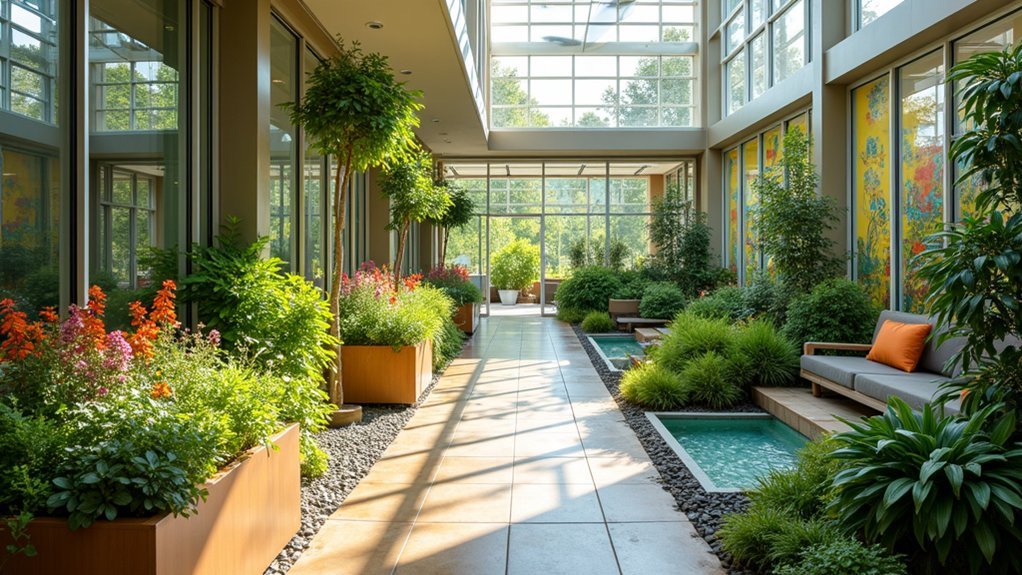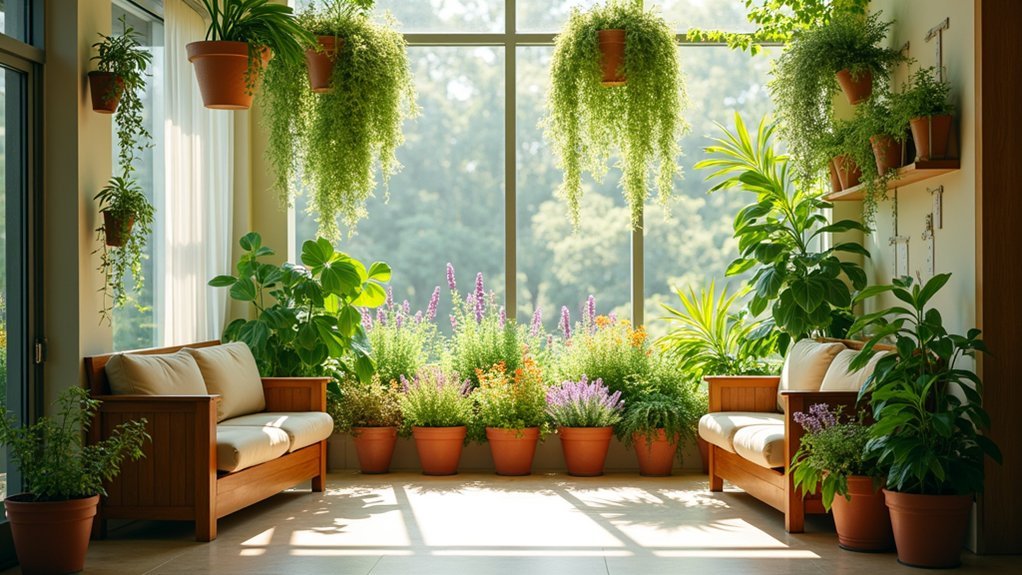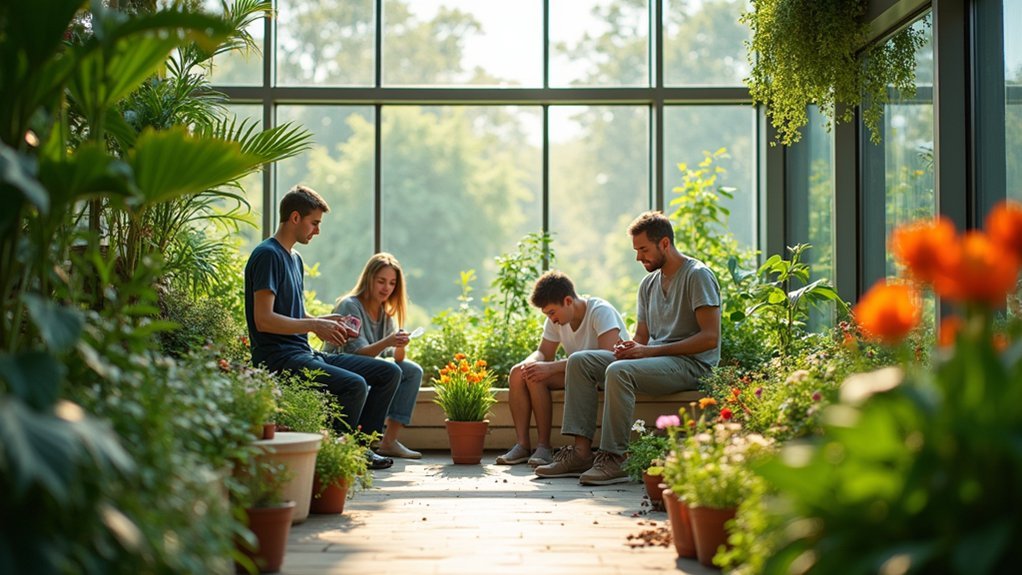You’ll transform your healthcare facility with these five indoor garden therapy tips: create wide pathways for wheelchair access, select non-toxic plants like Spider Plants and Boston Ferns, incorporate sensory-rich elements with various textures and fragrances, train staff to lead structured therapeutic activities, and implement measurement systems to track patient benefits. These evidence-based approaches can enhance patient recovery while creating calming, healing environments that complement traditional medical treatments.
Creating Accessible Garden Spaces for Patients With Limited Mobility

When designing indoor gardens for therapeutic purposes, accessibility must be at the forefront of planning.
You’ll need wide pathways that accommodate wheelchairs and mobility aids, ensuring all patients can navigate the space comfortably.
Place interactive planters and seating areas at accessible heights, allowing everyone to engage with the garden regardless of physical limitations.
Incorporate sensory-stimulating elements like aromatic herbs, textured plants, and gentle water features to create a multisensory experience.
Thoughtfully designed indoor gardens allow wheeled beds with patients receiving treatments to access green spaces without compromising care.
Consider implementing self-irrigation systems and low-maintenance plants to reduce upkeep demands.
These accessible design choices aren’t just practical—they’re therapeutic.
Research shows that thoughtfully designed garden spaces improve both mental and physical health for patients with limited mobility, providing a healing environment that everyone can enjoy.
Selecting Non-Toxic Plants for Therapeutic Indoor Gardens
Safety stands at the heart of therapeutic indoor gardening, especially when plants are introduced to healthcare environments where patients may have compromised health or cognitive abilities.
Safety first when bringing plants into healthcare spaces where vulnerable patients interact with therapeutic indoor gardens.
When choosing plants, prioritize species verified as non-toxic from reliable sources like university extensions and poison control centers.
Consider tried-and-tested options like the air-purifying Spider Plant, humidity-boosting Boston Fern, or the resilient Parlour Palm—all safe for children and most patients.
You’ll want to avoid plants containing harmful compounds such as saponins, alkaloids, or oxalates.
Place your selected plants at accessible yet safe distances, and group those with similar care needs together.
Remember that the best therapeutic plants not only pose no risk but actively contribute to wellbeing through improved air quality and psychological benefits.
Studies indicate that the introduction of appropriate houseplants can significantly improve mental health outcomes by reducing stress levels and promoting a sense of calm in medical settings.
Designing Sensory-Rich Plant Experiences for Mental Health

Designing sensory-rich plant environments transforms ordinary indoor gardening into powerful therapeutic experiences for mental health. Create spaces that engage multiple senses by incorporating plants with varying textures, colors, and fragrances. Consider lavender for calming scents, lamb’s ear for tactile stimulation, and bright flowering plants for visual interest.
For patients with dementia or Alzheimer’s, include familiar herbs and flowers that might trigger positive memories. Thoughtfully designed raised beds ensure accessibility for wheelchair users while allowing patients to engage directly with plants. Those with anxiety benefit from serene arrangements with gentle water features or wind-activated elements that produce soothing sounds.
For autism support, establish predictable layouts with clearly defined spaces. Encourage interaction by positioning plants at accessible heights and incorporating edible varieties when appropriate.
These thoughtfully designed environments reduce stress, promote mindfulness, and offer emotional solace in healthcare settings.
Implementing Staff-Led Horticultural Therapy Programs
Successful horticultural therapy programs require thoughtful implementation strategies that bridge healthcare and horticulture expertise.
You’ll need to develop clear programmatic goals focused on enhancing health outcomes through plant interactions.
Start by training your staff in both horticultural knowledge and therapeutic communication skills. Create protocols that facilitate collaboration between healthcare professionals and horticulturists.
Design activities that match participants’ abilities, offering both group sessions for social interaction and individual options for personalized care. Recent studies show that horticultural therapy can significantly improve quality of life for patients undergoing chronic hemodialysis treatments.
Implement robust monitoring systems to track health outcomes and participant satisfaction. Don’t forget to regularly collect staff feedback to improve operations.
As your program matures, consider expanding to community gardens and building local partnerships to increase impact. Include volunteers to support activities and guarantee sustainable resource management for long-term success.
Measuring and Tracking Therapeutic Garden Benefits for Patient Care

While implementing therapeutic garden programs lays the groundwork for healing environments, understanding their impact requires systematic measurement.
You’ll need both qualitative and quantitative approaches to fully capture the therapeutic benefits your indoor garden provides.
Consider these practical tracking methods:
- Combine methodologies – Use patient surveys alongside physiological measurements like cortisol levels to create a thorough assessment approach.
- Leverage technology – Implement sensors and mobile apps to efficiently collect data on garden usage and environmental conditions.
- Observe interactions – Document how different patient populations engage with the space through structured observational research.
- Conduct longitudinal tracking – Measure outcomes over extended periods to understand the sustainability of benefits and refine your therapeutic programming.
Current evidence quality regarding healthcare gardens is heterogeneous and would benefit from standardized measurement tools in future evaluations.
Frequently Asked Questions
How Do Indoor Gardens Affect Hospital Infection Control Protocols?
Indoor gardens require you to implement stricter infection control protocols, as they introduce potential microbial reservoirs. You’ll need regular maintenance, proper ventilation, and monitoring systems to balance therapeutic benefits against contamination risks.
Can Gardening Therapy Interact Negatively With Certain Medications?
Yes, your medications can interact negatively with gardening. You’ll need caution if you’re on blood thinners, immunosuppressants, or photosensitizing drugs. Soil exposure and physical activity might affect your medication effectiveness or safety.
What Insurance Codes Apply to Horticultural Therapy Sessions?
When billing for your horticultural therapy sessions, you’ll typically use CPT codes like 97150 (group therapy) or 97535 (self-care training). Coverage varies by insurance provider, so you’ll need to verify specific reimbursement policies.
How Do Indoor Gardens Impact Hospital Energy Costs?
Indoor gardens reduce your hospital’s energy costs by lowering HVAC demands through natural humidity regulation, improving insulation, and decreasing air conditioning needs. You’ll potentially save 10-32% on energy expenses while enhancing air quality.
When Should Gardening Therapy Be Contraindicated for Certain Patients?
You shouldn’t recommend gardening therapy for immunocompromised patients, those with severe allergies, patients who can’t safely handle tools, individuals with infectious diseases, or those experiencing acute mental health crises requiring controlled environments.
In Summary
You’ve now discovered how indoor garden therapy can transform healthcare environments. By creating accessible spaces, choosing safe plants, designing sensory experiences, training staff to lead programs, and tracking therapeutic outcomes, you’ll provide powerful healing opportunities. Whether you’re starting small or planning an all-encompassing program, remember that connecting patients with nature isn’t just beautiful—it’s medicine in its most natural form.





Leave a Reply